|
Kanapaha Presbyterian Church History
A History of Kanapaha Church in Gainesville, Alachua County, Florida
|
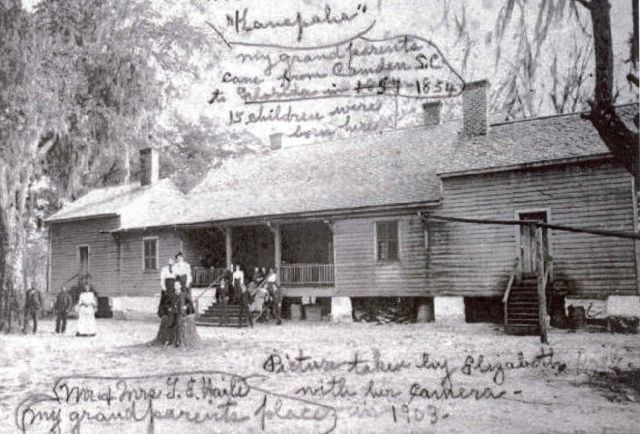
Kanapaha Church was founded in part by the Haile Family, formerly of Camden, SC. The Haile's named their farm Kanapaha Plantation
Overview
In 1854, a handful of Sea Island Cotton growers from South Carolina settled in this area, then known as Arredondo. It did not take them long to feel the need for an established church- a community to nurture and strengthen them in their faith. They sent back to South Carolina for their former pastor, the Rev. W. J. McCormick. He and his family arrived in the summer of 1857, and the first Presbyterian Church in this county was officially begun. Kanapaha is the mother church for the Presbyterian churches in Gainesville, McIntosh, and as far away as Ocala.
The history surrounding Kanapaha Presbyterian Church reaches all the way back to the first Florida pioneers, the Seminole wars, and the War Between the States. The generation from which our founders came was charged with taming a vast new wilderness state, devoid of even one single mile of paved road. Kanapaha Presbyterian Church has endured through nearly 150 years of the American experience, including the civil war, railroad booms, depressions and major shifts in population.
|
 |
|
|
|
 |
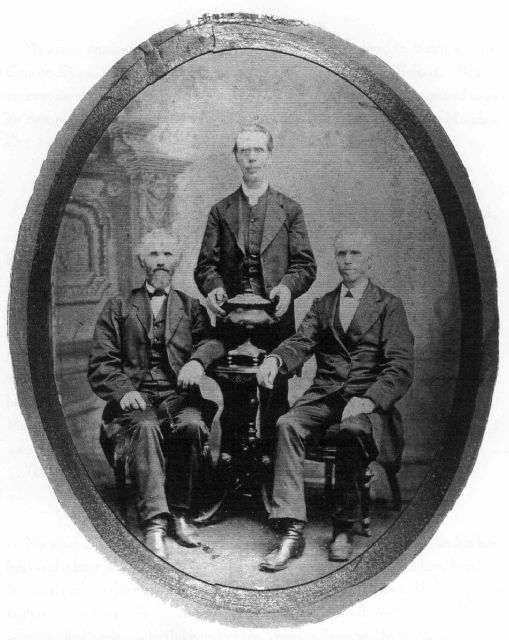
The Reverend Dr. William J. McCormick Sr., founding minister of Kanapaha, is pictured standing center with his two brothers. Brothers Jesse McCormick (left) and brother Warwick McCormick (right)
For History Enthusiasts...
Alachua county historians would find the book: Planters, Plantations and Presbyterians, Kanapaha & Reverend W. J. McCormick by F. D. McCormick of particular interest. Much, if not all of the documented history enveloping Kanapaha Presbyterian Church, as well as a detailed inventory of names of persons interred at the Kanapaha Presbyterian Cemetery, has been researched and compiled into this enjoyable read. Transcripts of Reverend McCormick's daily journals vividly recount this age of slavery, secession, reconstruction, the hardship of travel in 1850's Florida, and the bemoanings of a transplanted pastor trying to cope with the Florida heat.
A copy of this work is available in the Library at McCormick Hall, Kanapaha Presbyterian Church. It is also available from publisher and distributor, Fenwick Enterprises, 2143 SE 3rd Street Ocala, Florida 34471.
"Kanapaha"
To begin, it might be appropriate to give some explanation for the oddly sounding name appointed to this congregation. Kanapaha describes an area within the Arredonda Grant which marked the southern end of the Florida Cotton Belt. The word is thought to be Timucuan for palmetto leaves and house, and is apparently a reference to the thatched dwellings of the indigenous peoples of the Potano province (presently Alachua County). (8)
The Founders of Kanapaha Presbyterian Church
A number of large plantations were located in this general area, engaged in growing Sea Island Cotton. The majority of these planters came from South Carolina in the mid 1800's. Among them: Thomas and Edward Haile, who would establish the vast Haile Plantation in the Kanapaha area. On March 17th of 1854 (k) , Thomas and Serena Haile, dissatisfied with the turnout of several recent crops, departed Camden, South Carolina with the intent of emigrating to some other section of the country. Thomas Haile had an uncle in Missouri who had urged him to come out there and cast his lot with the growing west. (12) Mr. and Mrs. Thos. Haile had friends who had left South Carolina for Florida who had settled in Kanapaha. They packed up all their belongings, and went to Charleston, SC to book passage on a ship to Norfolk, VA, where they would disembark and go overland to Missouri. Once in Charleston, however, they found themselves unable to book passage to Norfolk, but they did find that they could charter a small schooner to take them to Florida immediately. This they did. (13) Upon arriving at Kanapaha, he bought 1500 acres of the Arredonda grant at $1.25 apiece, and settled here. They did so well with the cotton crop which they planted in March of 1855 (according to one family story, they plowed around some of the trees), that they sent word back to Camden; subsequently three other Haile brothers (Edward, Charles and John), Thomas' mother, Amelia and two of Serena's brothers (James and Thomas) moved to Alachua County. (k)
Shortly after the establishment of this handful of plantations, this group of devout Presbyterians felt the need for a church of their own. A number of these planters called an organizational meeting in the summer of 1857 for the purpose of securing a permanent church among them. Among the landowners in attendance were Messers (rare plural of Mr. is Messrs.: pronounced "messers", an abbreviation for the French messieurs), Thomas and Edward Haile, Thomas Chesnut, John Young, Ely Ramsey, Dr. W. H. Stringfellow, Dr. Robert Stuart and others. (9)
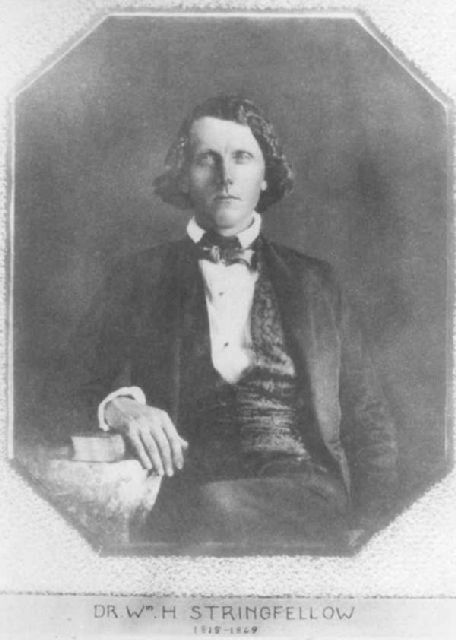
The group agreed and asked Dr. Stringfellow to return to South Carolina to consult with former friend and associate, the Rev. Dr. W. J. McCormick concerning his coming to Kanapaha and helping establish a church among them. Reverend McCormick, after repeated invitations, reluctantly traveled to Florida, and preached his first sermon in this county on the first Sabbath of January 1858. After resigning his pastorate at Liberty Hill, he came to Kanapaha with a wife, and three small daughters. They traveled from Charleston to Fernandina by water, on the Steamer "Everglades". There they were met by Thomas Haile to convey them to their destination. (10)
On the first day of January, 1859, the McCormicks went to live in the new manse, the only one then in this part of the country.
In the Fort Clark Church, on the plantation of Dr. Stringfellow, all denominations worshipped. Reverend McCormick held services there once each month while both the original Kanapaha Presb. Church and Gainesville Presbyterian Church were underway.
|
|
Building the first Kanapaha Church
After the completion of the building in April 1859, the church was formally organized, with 12 members and two elders, viz: Dr. W. H. Stringfellow and Mr. Joseph A Scott, with no deacons. In November of that year, Kanapaha was united with the Presbytery of Florida at Jacksonville. The first independently-standing Kanapaha Presbyterian Church was a starkly utilitarian structure roughly following the same dimentions as its subsequent namesake.
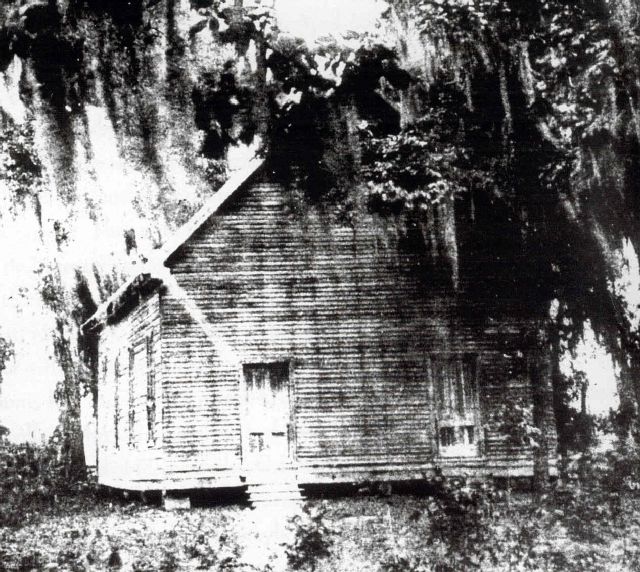
It stood at the western edge of that parcel of land presently occupied by the Kanapaha Presbyterian Church Cemetery, located past Kanapaha Botanical Gardens on SW 63rd Blvd in Gainesville. Kanapaha Prairie lies just to the back of the property, and it is said that on the edge of this prairie, a white man named Colson whipped an Indian for stealing a horse (or for having rustled cattle, depending on the folklore): this episode is supposed to have started one of the Seminole wars (22). This parcel was donated to the church by the Moses Ramsey family at the time of the church's inception, although the deed was not transferred officially until 1903. The original church was dedicated on the first sabbath in May of 1859 on this site. The church had suffered neglect throughout the civil war years, as many left to serve the confederacy. The Reverend McCormick himself joined as a chaplain to preach to the warriers in tented fields (24) . Finally, in 1864, McCormick returned to resume service at Kanapaha. History is sketchy during these years, however, documents indicate a wedding was scheduled at the original church for Nov. 26, 1878. Sermon transcripts make a reference to the building's existence as late as 1883. Finally, journal entries from Serena Haile note the following: "Fri Nov 7th [1884] Clear & bright morn - Cold - Clouded up around 11 am - Drizzly all day - raw & uncomfortable - George & Bennet went to Churchyard to sweep out church." Serena's previous references to the "churchyard" had to do with the cemetery. (k) Another entry from Mrs. Haile's journal logs the following: "Sunday Nov 9th [1884] a cloudy raw day - 'Mr Baker' here - Preached at Kanapaha Church - A Good Sermon - every body liked him - a large Congregation. Meeting for subscription for Minister's salary. Mr Baker staid the night - with us - Preached 4 pm at School house" (k) Based on the above accounts, it appears that the original Kanapaha Church remained in use at least until the beginning of 1885. During 1885, it is important to note that the Archer Presbyterian Church had just been completed, its design serving as the model by which many, including Kanapaha's replacement, would be crafted. Knowing that the Kanapaha Church had been yearning for a position closer to the railroad, that the condition of the original church following the war was said to be unsafe, that the congregation had begun to meet more frequently at the School house accross the railroad on the North side of the Edward Haile property (30), and that the Archer congregation had just freshly completed their model Presbyterian church, the timeline strongly suggests that the original Kanapaha Church was not lost accidentally in a fire, as rumored, but was very deliberately decommissioned. As the Kanapaha congregation continued to divide its services between the old church and the school house, elders purchased the site of the new Kanapaha Church, adjacent to the Kanapaha Station, in June of 1886. The new structure was dedicated in October of 1886. Given that people of this era typically wasted nothing, it is plausible that valuable timbers and other materials would have been salvaged for use in constructing the new church. The debris remaining at the old site was likely burned away, seeing as this site was to continue as the church cemetery. This may account for the rumors of the old church having burned. (24).
|
 |
|
|
|
 |
Building the New Kanapaha Church, South Arredonda
Following the civil war, the congregation decided to build a new church near the rail station of Kanapaha, a new center of population. David Yulee, businessman and politician, incorporated the Florida Transit Co. on January 8, 1853, creating the railway which would run right through Kanapaha. The civil war and Florida's having seceded from the union stifled the use of this line, as did Yulee's imprisonment at Fort Pulaski in Savannah following Lee's surrender to Grant at Appomattox in April 1865. Yulee returned to Cedar Key soon after his release, and successfully ran this railroad until it was sold in 1872 to the Atlantic, Gulf and West India Transit Co. It was along this route that a new center of population grew, and in time (1886), a new and second Kanapaha Presbyterian Church would be built just in time for a post-war boom, facing the Transit Railroad. This is the church that is presently standing and in use today at Archer Road and SW 75th St.
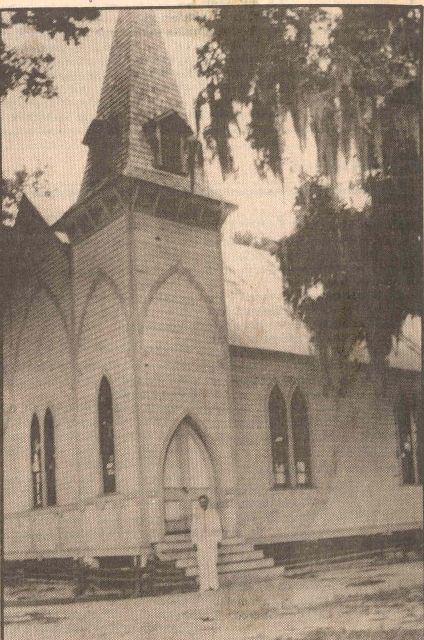
During this transition, Rev. Dr. W. J. McCormick, weakened by typhoid pneumonia, died on June 29th, 1883, never to see the raising of the new church.
The land upon which the new church would be built was conveyed by C. Olivia Sutherland and A.S. Sutherland to the Trustees of Kanapaha Presbyterian Church, Albert R. Elmore, R. F. Taylor, George P. King and Charles Breedlove for the sum of $50 on June 30th, 1886. (39)
Every feature of this historic Presbyterian landmark reflects the cherished traditions of its early workers. The red-bordered stained glass windows were purchased with monies earned by traveling throughout the community and selling homemade ice cream from the back of a horse-drawn buggy.
A fragment of paper credited as coming from the diary of Carol Haile's mother comments: "On Sunday, June 27th, 1886, the cornerstone for the New Kanapaha [Presbyterian] Church, South Arredonda was laid. [Rev.] A.B. Curry and Mr. J. D. Matheson assisted. On Sunday, October 17th, 1886, New Kanapaha Church, South Arredonda was dedicated by the Rev. A.B. Curry. Text: 24th Psalm, 9th Verse, Sermon just grand. Ellen Chesnut united with the church." (32)
History between the dates of 1886 and 1917 is anecdotal, since all the records bound in session minutes were lost in the fire which consumed the home of Elder, Mr. Bartley Massey, and daughter Mrs. J.H. Holly. Documents supporting accounts given for periods dating from 1855-1882 were salvaged from the Presbyterian Manse fire in 1882, as they were thrown from the burning home. (31)
Footnotes:
(Page No.) : Planters, Plantations and Presbyterians, Kanapaha and Rev. W. J. McCormick by F.D. McCormick
(k) : Supplemental historical data contributed by Karen Kirkman, Docent, Historic Haile Homestead Organization
|
|
The Twentieth Century
The advent of the new century, following the fits and starts of post-civil war reconstruction would witness America embarking on a path of exponential growth. The Plantation economy which fueled the South- particularly the Kanapaha region, ceased to exist. Abolition and the Industrial Revolution would mechanize agriculture, and so would go the population from the farmlands, where they were no longer needed, to the cities where they would seek work, and take up residence. The first half of the twentieth century dealt Kanapaha Presbyterian Church several blows: Population shifts, Depletion of Membership as a result of World War I, the Great Depression, World War II, the Boll Weavil, and the discontinuance of the Transit Railroad which drove much of the early settlement along this route. These factors caused the Kanapaha church to find herself no longer situated in a center of activity. Kanapaha's existence devolved into one of remote outpost; resigned to landmark status. The viability of Kanapaha Presbyterian Church continuing as an active congregation became seriously questioned and thus, during the years 1946 and 1947, the doors were closed.

Demolition of First Baptist Church of Gainesville, ACLD Heritage Collection
Gainesville was also witnessing a metamorphosis of sorts during the early 1950's. Throughout town, there arose a popular movement to dispense with architecture that had become too familiar- and as we know of human nature, familiarity breeds contempt.

At its most fevered pitch, the finest architectural jewels, hand-crafted by the last generation of old-world artisans and craftsmen, fell in their prime to the wrecking ball. Among them were the magnificent Alachua County Courthouse, First Presbyterian Church, First Baptist Church (pictured, courtesy Alachua County Library District), and many, many others.
First Presbyterian Church of Gainesville, ACLD Heritage Collection (Note: the leaded glass window from the Sunday School room of this building "Earnest Workers" was spared and incorporated into Kanapaha Church)
Reopening the Doors
In the year 1948, the Kanapaha Presbyterian Church Council, headed up by Mrs. Hazel S. Rice, with the help of Olive Williams, Elsie & Herb Garver and many others, reopened the doors for services. The area had begun to see a modest growth trend, and membership hovered around 45, a mark of success against the former high-membership mark of 36 in 1914. Still yet, the town had not, and would not grow for many years to come in such measure as to render the Kanapaha church fully sustainable.
|
 |
|
|
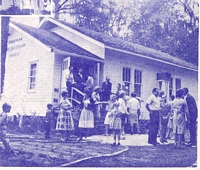 |
 |
Kanapaha Moves East, Then Back Again...
In 1960, the decision was made to relocate Sunday Worship several miles closer to town. Kanapaha Presbyterian acquired the former University Lutheran Church building and property located adjacent to Stengal Field (site of present-day Texas Roadhouse). From 1961 to 1970, the congregation continued in this low-key wood-frame converted house. By the late 1960's, the mother church, sitting quietly several miles to the west had found itself infested with bees in the belfry to the extent that honey would flow down the walls of the narthex. By 1969, members having been grousing over the move for five-some years, stated that the "new" church at Stengal Field "never really felt like a church". In 1970, the property was sold, and someone made an offer to donate the building and MOVE it to Kanapaha Church. A massive renovation project was put underway to rehabilitate the historic sanctuary, evict the bees, and fully outfit it with electrical wiring, carpeting, and central heat and air. The Stengal Field building, once being set onto its new foundation adjacent to the historic church, became renovated into what is now McCormick Hall. In this year, the congregation joyously painted the buildings, preened the grounds, developed recreation facilities, as well as nursery services. The Congregation of Kanapaha was home again.
|
|
Vandals Destroy Church Property
In November of 1972, the Kanapaha Presbyterian Church was struck hard by vandals. Nearly all of the windows were broken, including many of the original kerosene lamps in the central chandelier. Although repairs were made to most of the damaged glasswork, the much-celebrated window in the chancel, an artifact from the 1890-built First Presbyterian Church of Gainesville, was in need of expert attention, and so it was removed, boarded up, and a campaign to garner funds from the community went underway in order that it might be restored the following year.
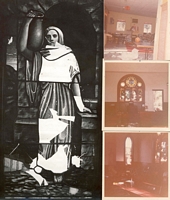
Everybody Pitched In
In June of 1974, Kanapaha held a "Buildings and Grounds Day", and under the leadership of Pastor Steve Sewell, the University of Florida College of Law, of which he was an alumnus, pitched in to paint the sanctuary, work over the grounds, and glaze the windows
The Iran Hostage Crisis
During the Iran Hostage Crisis when the Ayatollah Khomeini took 53 Americans hostage for 444 days from November 4, 1979 until their release on January 20, 1981, members of Kanapaha Presbyterian Church faithfully and prayerfully rang the church bell 53 times each and every day the Americans were held captive. Contributed by Gery Kovatch
Shoot-Out at Kanapaha Church!!
The Kanapaha region, surrounded by open space and pasture, is known for many things, but crime is not one of them... Nevertheless, December 5th, 1982 was a date worthy of note. Ronald Eugene Watts shot and stabbed two men during an attempted robbery on this day. Four men were leaving the church when a man armed with a single barrel shotgun, a pistol, and a large knife pointed the shotgun at them, demanding the keys to their cars. Herb J. Garver, one of the church members, began arguing with the man, and was stabbed in the chest. Watts then demanded the keys from Rober Hicks. Hicks refused. At that moment, Rev. Herb Parsons ran to call for help, locking the doors of the office behind him. The gunman tried to get into the church, turned around and shot Hicks. Don F. McCormick managed to duck, escaping injury during the incident. Both injured men recovered from their wounds. Watts had been in the custody of Macclenny State Hospital following two previous criminal incidents, and his release remains, to this day, the topic of heated discussion. Nabbed by the Alachua County Sheriffs department three days after the attack, Watts stood trial for attempted murder before Circuit Judge R.A. Buzzy Green Jr., where he was sentenced in February of 1984 to 99 years in prison.
130th Anniversary
1986 marked an important anniversary for Kanapaha Presbyterian Church. On October 17th, we celebrated 100 Years since the dedication of this Sanctuary. This year coincided with the 130th anniversary of the founding of this congregation by the first pioneers.
|
 |
|
|
|
 |
Women in Ministry
1993 represented a pivotal year in the life of this and many other Presbyterian congregations. Upon Rev. Herbert Parsons' retirement, following a decade of service to our church, the Board of Session had some difficult decisions to make. The Pastor Nominating Committee solicited potential new pastors to fill the impending vacancy. Among the applicants was Pastor Susan Reggin. A woman of intelligence and conviction, coupled with a warmth and intuition that seemed made-to-order, Rev. Reggin's qualifications were a shoo-in for the position, save for one thing: She was a woman. The Committee and the Session wrangled with sharp criticisms, and a very real potential to lose members of the congregation should they vote in favor of installing Kanapaha's first female pastor. Going on faith, they brought Rev. Reggin on board. During her first tour of the sanctuary, she caught a glimpse of the window in the chancel. With the biblical figures of Ruth and Naomi showcased front and center at the pulpit, she felt right at home. She was installed that year. Many members of the congregation who threatened to leave did so by nearly half, and they took their money with them.
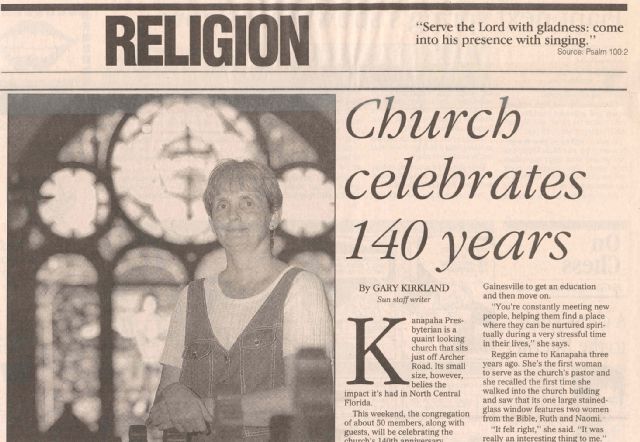
By the end of Rev. Reggin's tenure at Kanapaha, new membership had substantially overcompensated for that which was lost.
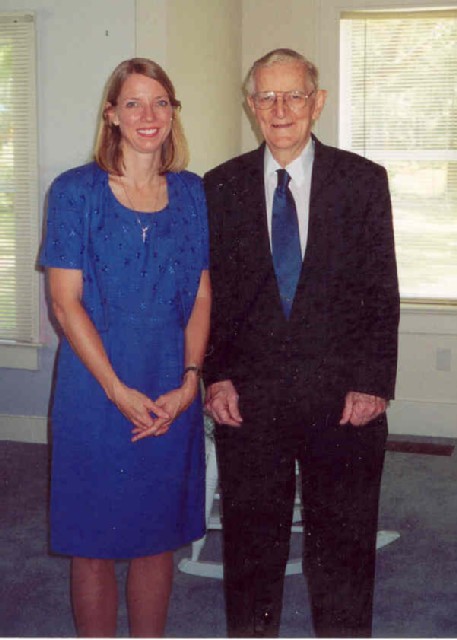
Since this groundbreaking decision, Kanapaha has enjoyed the ministry of three highly-gifted pastors, who also happened to be women. This policy of acceptance is a visible distinguishing trait of the Presbyterian Church USA. (pictured: Rev. Dr. Dawn Conti, Rev. Dr. Graham W. Hardy)
|
|
The Twenty First Century
By the recentmost turn of the century, Kanapaha was enjoying a healthy membership, reasonable financial footing, and the real prospect of the very, very long-awaited arrival of the town on her doorstep. Short of hauling the church to the city, history would prove that it would take only 148 years for the city to catch up with the church.
At the same time, it was becoming painfully clear that the buildings had certain problems that needed to be addressed. For one thing, the window in the chancel, spared from the wrecking ball at First Presbyterian Church of Gainesville in 1954, and plucked from a fire in a warehouse, only to be installed in the headwall of the Kanapaha church for an additional 50 years of blazing sun, icy wind, driving rain, vandals, and corrosion was bagging outward, and nearing collapse under its own immense weight. The windows along the sidewalls, though patched in 1973 following the vandalism, were still noticeably missing certain mill works, and the broken red borders, those pieces bought with the proceeds from the ice cream in a buggy, had been replaced with red plastic.
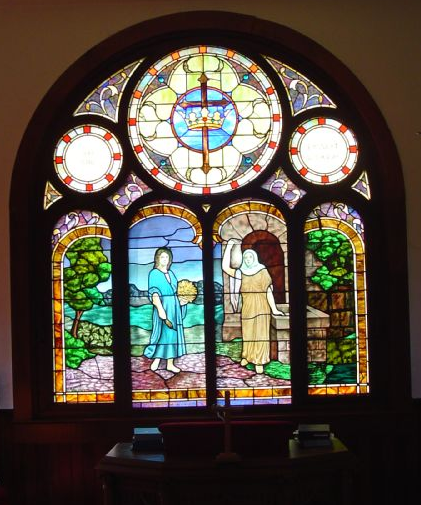
The Chancel Window received a complete disassembly and restoration by Advent Glassworks in 2002. At a cost of nearly $20,000, this rated among the most expensive undertakings Kanapaha has ever engaged. The gothic side windows soon received equal restorative work, which required baking a fresh supply of glass with the original inset patterns.
The Steeple atop Kanapaha, which was originally a 22-foot spire with four louvered dormers, finished in cedar shakes, had been largely lost in a hurricane, possibly in 1947. It was reconstructed in an abbreviated form, looking more like a mansard cupola rising only about 8 feet above the frieze. When the asphalt shingles began falling from it, and the cross crafted from window screen frame tilted over, something had to be done.
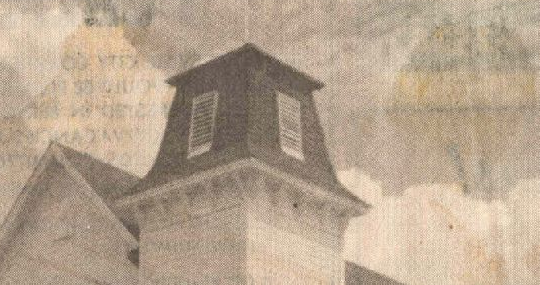
The Steeple had been specially designed and commissioned by the Session in 2001 to replace the rotting one. The new steeple restored Kanapaha's stature to the height and dimentions of the original, and with an eye toward future restoration of the sanctuary roof, it was recreated with 1890's style Norman Type-A Victorian metal tiles. Though Kanapaha's original steeple was finished in shakes, fire code and weather-resistance dictated a higher-quality material, and many similar 1880's-era Presbyterian churches were originally clad in the same.
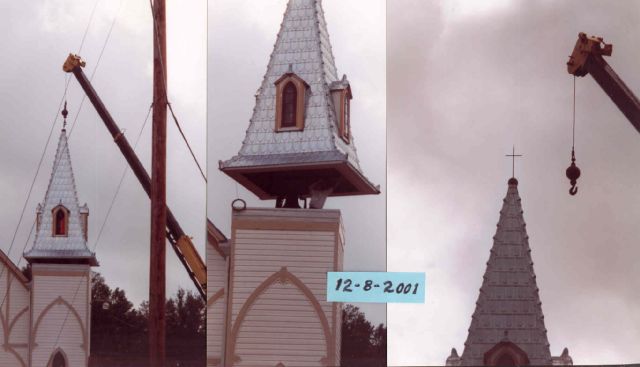
The new steeple incorporated four full-size dormers, complete with scale replica windows patterned after those found throughout the sanctuary. The four sashes are linked mechanically to swing open each time the church bell is tolled, and close automatically afterword. It has also been outfitted with a pneumatic hammer to chime at the top of each daytime hour. Coupled with an atomic clock, if the Kanapaha bell tower chimes, and your watch doesn't show top o' the hour... well... your watch is wrong. It was constructed off-site with a full steel beam inner skeleton to withstand hurricane force winds, and carefully craned atop the corner tower to the delight of onlookers on December 8th, 2001.
|
 |
|
|
|
 |
New Fellowship Hall Replaces Old Kokomoor Outbuilding
Aside from the routine sprucing up of the buildings and grounds, the last major project awaiting Kanapaha is the construction of a new Fellowship Hall. Since 1949, the existing fellowship hall, a cinder block utility building with an occupancy of about 35 persons, has served as the only kitchen, bathroom and fellowship facilities for our church. Built with help from the Boy Scouts, its foundation heaved so badly that the walls teetered outward at every corner. Mold thrived on the walls, and the linoleum floor sweated with moisture when the outside temperature changed.
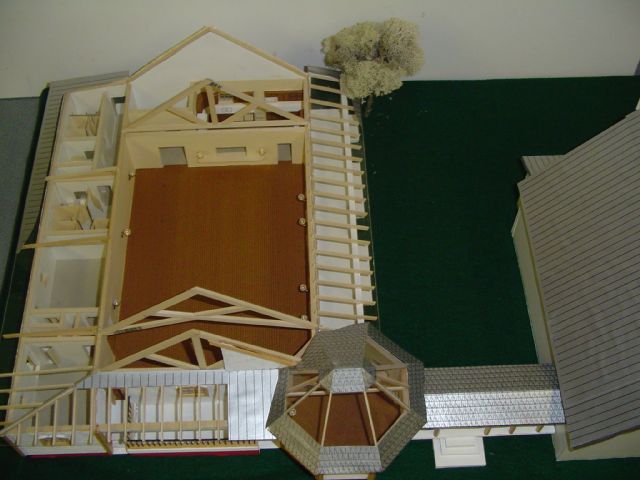
Plans had been made three times in the past to build a roomier, more aesthetically pleasing hall, but none were sufficiently inspiring to raise necessary funds, and never came to fruition. The 2005 plan called for a new hall to replace the original, built with respect to the lines and architectural vernacular of the historic sanctuary, with every attention to detail aimed at providing the best accommodation possible for the congregation and our larger community, while carefully preserving the integrity of the overall campus and green space. It incorporates a columned walkway connecting the sanctuary and the fellowship hall, ensuring that the floors of both buildings are at equal height. This will allow effortless travel for everyone attending Kanapaha, especially those in wheelchairs, to all points among the two buildings, in any kind of weather. The new fellowship hall, completed in 2006, now includes a fully-equipped kitchen, nursery, sunday school room, spacious restrooms, storage, a large general purpose hall, and patio space overlooking a landscaped courtyard, complete with fountain.
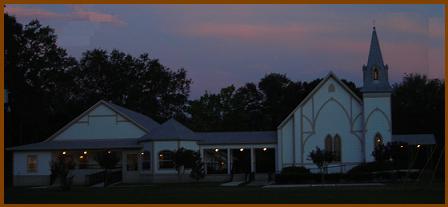
Helpful Links:
To view Library of Congress Historic American Buildings Survey archives of Kanapaha Church architectural drawings (courtesy of University of Florida College of Architecture) please visit: http://www.loc.gov/pictures/search/?q=kanapaha
For information on Kanapaha Cemetery please visit the following site: http://www.rootsweb.com/~flalachu/Cemetery/KanapCem.html
For a Historical Chronology of Alachua County and Gainesville, FL please visit: http://www.alachuacounty.us/Govt/Pages/AlachuaCountyHistory.aspx
For an excellent History of how the Railroads Built this Region please visit: http://www.explorehistoricalachuacounty.com/location/gainesvilles-railroads/
For additional information about the Haile Plantation historical site, please visit : http://www.hailehomestead.org/
http://www.kanapaha.net/warren_thomas.html
|
|
|
|